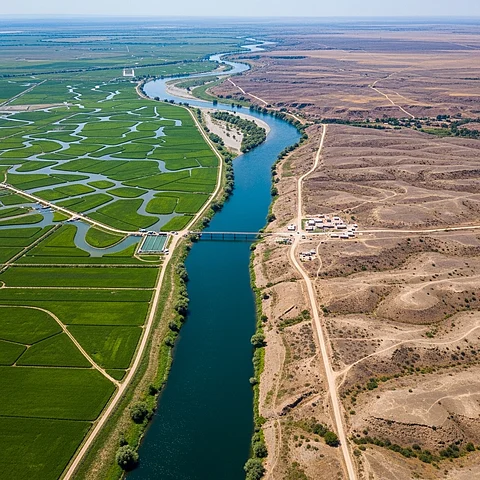

The Banakacherla Project has ignited a contentious conflict between Andhra Pradesh (AP) and Telangana (TG). Central to the dispute is AP's initiative to redirect floodwaters from the Godavari River to support agricultural activities in its drought-affected regions, a move it considers vital for its development. In stark opposition, Telangana vehemently contests this plan, arguing that it violates established water-sharing agreements and threatens its water security. The state is gearing up to challenge the project in the Supreme Court.
On the political landscape, AP's ruling Telugu Desam Party (TDP) is leveraging their ties with the central government to champion the project, labelling it a transformative endeavour for the area. Conversely, the Congress-led government in TG is actively opposing the initiative, claiming the previous Bharat Rashtra Samithi (BRS) administration colluded on the matter while emphasising the need to protect the state's water rights. Meanwhile, the BRS, now in opposition, has criticised the current Congress government’s handling of the situation but continues to reaffirm its stance against the project.
Interlinking of Godavari, Krishna & Penna
Proposed by the AP government, the Banakacherla Project aims to divert excess water from the Godavari River to the Krishna and Penna rivers, addressing the water scarcity in drought-prone areas such as Rayalaseema, Nellore, and Prakasam. This initiative is overseen by the Jala Harathi Corporation, a special purpose vehicle, with the Chief Minister at the helm and the Irrigation Minister serving as Vice Chairman. The project is estimated to cost between Rs 80,112 crore and Rs 81,900 crore, with funding structured to include 50% from external aid, 20% from the central government, 10% from AP’s own funds, and the remainder through a Hybrid Annuity Model.
The project envisions an interlinking of the Godavari, Krishna, and Penna rivers, utilising surplus water from the Polavaram Project. The mega irrigation scheme aims to divert around 200 to 244 TMC of Godavari floodwater to water-scarce regions, primarily targeting Rayalaseema through a reservoir at Banakacherla and an extensive network of canals. It seeks not only to provide irrigation and drinking water but also to facilitate industrial water supply. Key components of the project include a head regulator at Banakacherla for flow control, a proposed 150 TMC reservoir at Bollapalli in Guntur district, and canals to channel water to various regions, including Prakasam, Nellore, and Rayalaseema.
Focus on Drought-Prone Rayalaseema
Banakacherla Project aspires to mitigate drought effects in regions like Rayalaseema, potentially irrigating 3 lakh hectares and providing drinking water for 80 lakh individuals. By enhancing irrigation, the initiative aims to bolster agricultural output and uplift rural living standards. Additionally, it allocates 20 TMC for industrial purposes, which could stimulate industrial development and attract investments in water-scarce areas, thereby optimising water resource management. AP Chief Minister Chandrababu Naidu has sought federal backing, indicating the project’s strategic significance at the national level.
However, environmental concerns loom large as activists warn that large-scale river interlinking and reservoir construction could disrupt local ecosystems, adversely affect aquatic life, and shift river flow patterns. Furthermore, the project’s financial burden could weigh heavily on AP, given its substantial cost and reliance on loans. Also, inter-state tensions are palpable, with Telangana raising alarms over what it perceives as illegal water diversion that infringes on its rights.
Reasons for the Telangana Govt and the BRS Opposition
Led by Chief Minister Revanth Reddy, the Telangana government and the BRS have firmly opposed the Banakacherla-Polavaram project, asserting that diverting 200 to 244 TMC of Godavari water violates their rightful share. The project has also faced criticism for its unilateral approach, lacking adequate consultation with affected parties, such as the Central Water Commission.
The longstanding debate surrounding river-linking between the states intensified following the bifurcation of Andhra Pradesh in 2014, which left several water-sharing agreements unaddressed. Retired irrigation engineers and educationalists have suggested alternative plans to foster mutual benefit. Possible paths toward resolution include negotiating a bilateral agreement with oversight from the Central Water Commission, ensuring equitable distribution of Godavari water.
Mediation by the Centre Could Pave the Path
Involving the central government in mediation discussions and creating compensatory projects could also foster cooperation. AP could also support irrigation initiatives within TG to counterbalance any perceived losses caused by the Banakacherla Project's execution. While the Banakacherla Project presents an opportunity for significant agricultural and industrial advancements in AP, it faces substantial opposition from TG due to concerns over water rights and environmental impacts. A collaborative and transparent approach will be crucial in resolving this interstate dispute to maximise water resources for both states.
